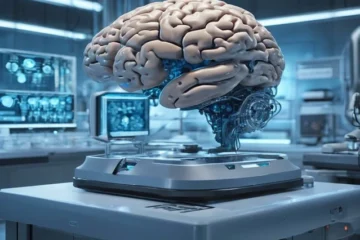Artificial Super Intelligence
To understand Artificial Super Intelligence, we should learn some root terms about ASI, will able us to understand ASI easily.
Intelligence
The ability of learning, understanding, and how to response the environment.
The Evolution of Intelligence.
“The Key to Human Dominance.”
Intelligence has evolved over time, with different species developing different forms of intelligence. Humans have general intelligence, which has been the key to our dominance on the planet. Understanding the evolution of intelligence can help us better understand the potential of AI and its implications for humanity. The evolution of intelligence is an increase in the size, development and complexity of the nervous system and the brain. From simplest (Flatworms) to most complex (Humans) beyond the human.

Simple nervous system
Flatworms have simple nervous system intelligence in primitive form.
More complex nervous system
Reptiles and mammals have more complex and developed brain and able to response and adopt environment.
Most developed nervous system Humans contain most developed brain. Humans are able to think abstractly, reason, plan, and can solve problems more efficiently.
Beyond humans:
Intelligence forms of future by theories tells that in future an AI system will be developed, which will be most developed beyond the human brain and will possess more potential and capabilities to tackle the problems than present intelligence. Humans have the most advanced form of intelligence, but it is not the only form and there is still much to learn about the potential of other forms of intelligence.
Types of intelligence
“Narrow Intelligence vs. General Intelligence”
Narrow Intelligence (NI)
Such type of AI systems which are able to do a narrow task, for example recognition of image natural language processing or searches by internet. Also known as weak AI or specific AI. It has ability to transfer knowledge to new domains in limited manners. Means it has a limited range for its functioning. Currently prevalent in most AI applications.
General Intelligence (GI)
AI systems which are designed in Such a way that it posses the abilities to acknowledge, determine, and use knowledge across a wide range of tasks, as human intelligence does. Also known as strong AI or artificial general intelligence (AGI). It is applied in wide range of tasks and knowledge is transferred from one domain to another by general intelligence. Has not yet been achieved but is the ultimate goal of AI research.
Challenges in developing GI
For AI researchers, it is a significant challenge to develop general intelligence, but till now there is no clear path for designing machines by applying true general intelligence.
Human Dominance
Today general Intelligence is the main reason for human dominance in the world, due to which we are able to adopt new situations accordingly, learn from experience, and problems in a variety of domains can be solved. General Intelligence is possessed by human beings, due to which we are able to adapt to new situations and learn new skills quickly. We dominant because human can think abstractly and creatively. Narrow AI may excel in specific tasks, but it lacks the flexibility and adaptability of human intelligence.
The Emergence of Artificial Super Intelligence:
Artificial Super Intelligence
We can tentatively define a super intelligence as any intellect that greatly exceeds the cognitive performance of humans in virtually all domains of interest. Note that the definition is noncommittal about how the super intelligence is implemented. It is also noncommittal regarding qualia: whether a super intelligence would have subjective conscious experience might matter greatly for some questions (in particular for some moral questions), but our primary focus here is on the causal antecedents and consequences of super intelligence, not on the metaphysics of mind. True super intelligence (as opposed to marginal increases in current levels of intelligence) might plausibly first be attained via the AI path. There are, however, many fundamental uncertainties along this path. This makes it difficult to rigorously assess how long the path is or how many obstacles there are along the way. T he whole brain emulation path also has some chance of being the quickest route to super intelligence. Since progress along this path requires mainly incremental technological advances rather than theoretical breakthroughs, a strong case can be made that it will eventually succeed. It seems fairly likely, however, that even if progress along the whole brain emulation path is swift, artificial intelligence will nevertheless be first to cross the finishing line: this is because of the possibility of neuromorphic AIs based on partial emulations.
A New Era for Humanity
Types of Artificial Super Intelligence
There are three main types of ASI.
- Speed super intelligence: A system that can do all that a human intellect can do, but much faster.
- Collective super intelligence: A system composed of a large number of smaller intellects such that the system’s overall performance across many very general domains vastly outstrips that of any current cognitive system.
- Quality super intelligence: A system that is at least as fast as a human mind and vastly qualitatively smarter.
Goal of Artificial Super Intelligence (ASI)
The Main goal of ASI is to design the machines with the application of general intelligence by which human intelligence should be surpassed in virtually all economically valuable work.
The Rise of Self-Learning Machines
- The technological landscape is changing due to self-learning machines, a new generation of AI. Without explicit programming, these machines have the ability to learn and improve from the

Key Features of Self-Learning Machines
Autonomy
These machines possess the ability to learn and make decisions independently
Adaptability
By learning from previous data, these are able to adopt new situations and environments accordingly.
Generalization
Knowledge learned in one domain is applied to another, demonstrating generalization abilities of self-learning machines.
Applications of Self-Learning Machines
Self-learning machines have a wide range of applications, including:
Autonomous vehicles
Machine learning algorithms are used to navigate and make decisions in self driving cars.
Natural language processing
Self-learning machines have capabilities to understand and generate human language. Due to this ability these are enable to be used such as virtual assistants and chatbots.
Computer vision
visual data can be analyzed and understood by self-learning machines. That’s why have applications such as image recognition and object detection.

Challenges
Job Displacement
Self-learning machines widely used now a days. The increase in use of these machines are replacing human beings e.g. drivers, home workers etc. Due to this wide use of self-learning machines joblessness is increasing.
Privacy and Security
By the use of AI privacy and security concerns has raised, as it often involves the collection and analysis of large amounts of personal data.
Ethical Considerations
There are also ethical considerations when it comes to the use of AI, such as ensuring fairness and avoiding bias in AI algorithms.
Intelligence Explosion
A hypothetical scenario in which human intelligence will be surpassed by AI, is known as intelligence explosion. The concept of recursive self-improvement is the basic idea for intelligence explosion, in which AI is able to improve its own capabilities at an exponential rate. Technological singularity is its other name.
Let an ultra-intelligent machine be defined as a machine that can far surpass all the intellectual activities of any man however clever. Since the design of machines is one of these intellectual activities, an ultra-intelligent machine could design even better machines; there would then unquestionably be an “intelligence explosion,” and the intelligence of man would be left far behind. Thus, the first ultra-intelligent machine is the last invention that man need ever make, provided that the machine is docile enough to tell us how to keep it under control.
Implications of the Intelligence Explosion
A rapid advancement in a wide range of fields, including medicine, transportation, and communication can lead by intelligence explosion. But it is also risky to use because potential for misuse or unintended consequences is possessed with it. It is important to consider the ethical and societal implications of the intelligence explosion in order to ensure that it is developed and used in a responsible manner.
Recent Developments and Future Directions
The development of deep learning algorithms and the increasing availability of data is the Recent advancements in AI. These advancements have brought the intelligence explosion closer to becoming a reality. But its not easy to tackle the technical challenges before the explosion can occur. In order to ensure that intelligence explosion is beneficial for humanity, safety and ethics is an important of focus in AI research.
Conclusion
As human has most developed brain but still, we want a system which should work more effectively and efficiently than human brain. A super intelligence as any intellect that greatly exceeds the cognitive performance of humans in virtually all domains of interest. Some experts believe that the development of ASI could lead to a new era for humanity, while others warn of potential risks. It is important to consider the implications of ASI and to have a plan in place for how to handle its development and potential consequences.
By
Zeenat Mushtaque, MPhil Solid State Physics
Dr. Abid Hussain Nawaz, Ph.D.
Rumana Gull, Scholar Master of Philosophy Biological Sciences



